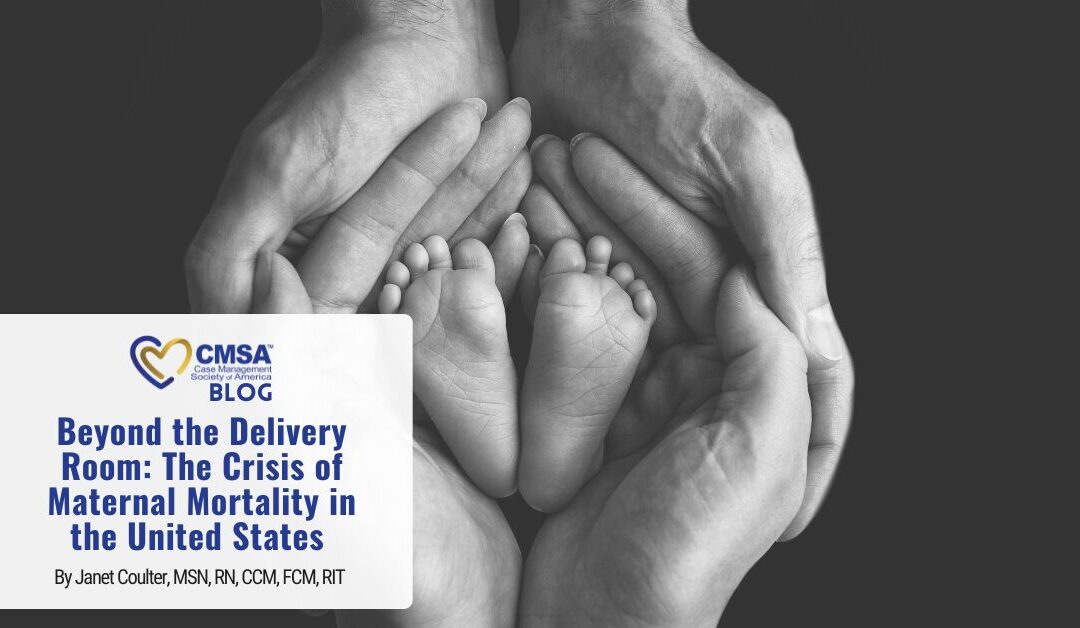By Janet Coulter, MSN, RN, CCM, FCM, RIT
The United States continues to face an alarming crisis in pregnancy-related deaths. A new study published in JAMA Network Open (April 2024) reveals that maternal deaths in the U.S. rose nearly 28% from 2018 to 2022. For those of us working in case management and patient advocacy, these numbers are more than statistics—they represent lives lost, preventable harm, and missed opportunities for early intervention. The study, led by researchers at Harvard Medical School, Boston Children’s Hospital, and Beth Israel Deaconess Medical Center, utilized data from a CDC database to examine trends in maternal mortality. Over the five-year period, 6,238 pregnancy-related deaths were reported among women ages 15 to 54. The national maternal death rate jumped from 25.3 to 32.6 deaths per 100,000 live births. These are the highest rates among developed nations, and they signal a systemic failure in how we care for pregnant and postpartum individuals.
One of the study’s most important findings is that about one-third of these deaths occurred more than six weeks after childbirth. Traditionally, a new mother’s final recommended check-up happens around the six-week mark. Yet for many women, critical health complications—both physical and mental—persist well beyond that time. This calls for a major rethinking of postpartum care.
The data also highlight glaring racial and ethnic disparities. Native American and Alaskan Native women experienced the highest maternal death rate at 106.3 deaths per 100,000 live births. Black women followed with 76.9 deaths per 100,000 births—more than double the national average. Hispanic, and Asian women experienced the lowest rates. These disparities are not new but remain deeply entrenched, pointing to systemic issues in access to care, implicit bias, and the social determinants of health.
Geographic location also plays a critical role in outcomes. Maternal mortality varied widely across the U.S., with rates more than three times higher in some states. Alabama had the highest rate (59.7 deaths per 100,000 live births), followed closely by Mississippi. In contrast, California had the lowest rate at 18.5. If every state had matched California’s outcomes, the study’s authors estimate over 2,600 maternal deaths could have been prevented. This staggering statistic underscores the power of state-level policies, access to services, and coordinated care systems in shaping outcomes.
The leading cause of pregnancy-related deaths during this period was cardiovascular disease—a preventable and manageable condition in many cases. Other top contributors included cancer, mental and behavioral health disorders, and drug- or alcohol-related deaths. These causes are a reminder that maternal mortality is not just about labor and delivery—it is about chronic disease management, mental health support, addiction care, and overall well-being.
For professional case managers, this study reinforces the importance of longitudinal care and patient advocacy. Case managers are in a unique position to assess risk, provide patient education, ensure timely follow-up, and connect families to critical resources. We play a vital role in coordinating care across disciplines—from OB/GYN to cardiology to behavioral health. We help patients navigate fragmented systems, especially in underserved or high-risk communities, and we are often the first to identify warning signs that others may miss.
This report also strengthens the case for systemic reform. The expansion of Medicaid postpartum coverage to 12 months, now adopted by many states, is a step forward. However, more must be done to standardize care access and expectations nationwide. Case managers must continue to champion policies that address disparities, fund maternal health initiatives, and hold systems accountable for equitable outcomes.
Maternal mortality in the United States is not an unsolvable problem. It is a call to action. With the right policies, investments, and coordinated efforts, we can ensure that no woman loses her life because of where she lives, the color of her skin, or the number of weeks postpartum she is. As care managers, we must lead with vigilance, compassion, and a firm commitment to life beyond the delivery room.
Join us in Dallas, TX, June 24-27, 2025, as we celebrate 35 years of case management excellence and innovation at the premier CM education and networking event of the year, the 2025 CMSA Annual Conference & Expo. https://cmsa.org/conference/
Bio: Janet Coulter, MSN, MS, RN, CCM, FCM is President of CMSA. She is a transplant case manager with a wide variety of experiences including educator, administrator, team leader, and Director of Case Management. Janet holds a Master of Science in Nursing from West Virginia University and a Master of Science in Adult Education from Marshall University. She has published many articles in CMSA Today and the Professional Case Management Journal and served as a reviewer for the Core Curriculum for Case Management Third Edition. She has served as President-Elect of CMSA, Chair of the CMSA Today Editorial Board, Chair of the Nominations Committee, and Vice-President of the CMSA Foundation board. Janet was the recipient of the CMSA National Award of Service Excellence and Southern Ohio Valley CMSA Case Management Leadership award and was recently inducted as a Case Management Fellow from CMSA.
References
Chen, Y., Shiels, M. S., Uribe-Leitz, T., Molina, R. L., Lawrence, W. R., Freedman, N. D., & Abnet, C. C. (2024). Pregnancy-related deaths in the US, 2018-2022. JAMA Network Open, 7(4), e245932. https://doi.org/10.1001/jamanetworkopen.2024.5932
Becker’s Hospital Review. (2024, April 9). US maternal deaths jump 28%: 5 study notes. https://www.beckershospitalreview.com/public-health/us-maternal-deaths-jump-28-5-study-notes.html
The New York Times. (2024, April 9). U.S. maternal deaths rose sharply during the pandemic, study shows. https://www.nytimes.com/2024/04/09/health/maternal-mortality-cdc.html
JAMA Network. (2024). Pregnancy-related deaths in the US, 2018-2022. https://jamanetwork.com/journals/jamanetworkopen/fullarticle/2818681

